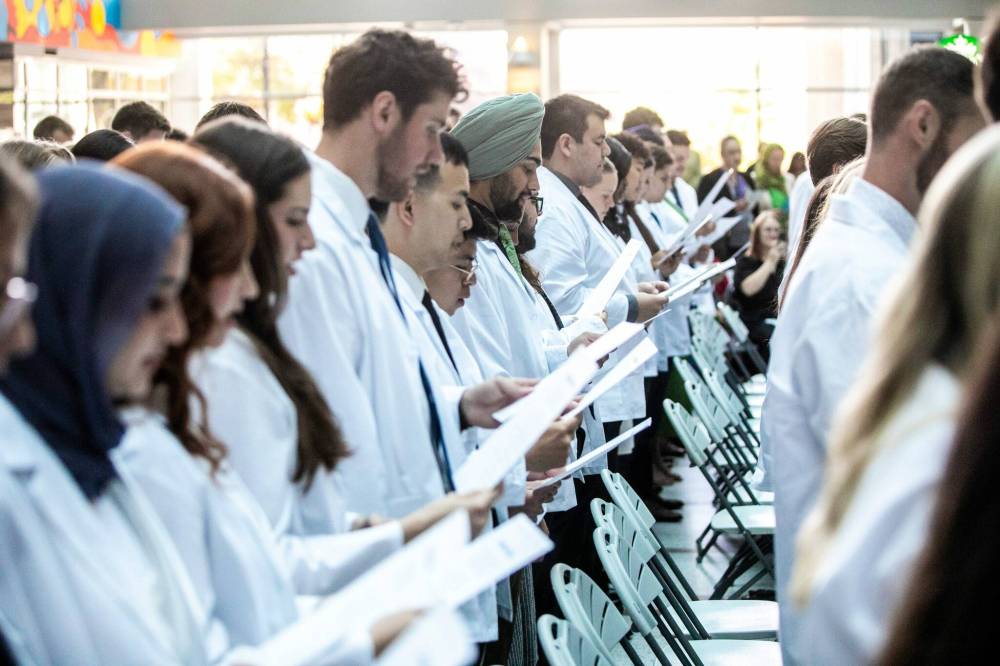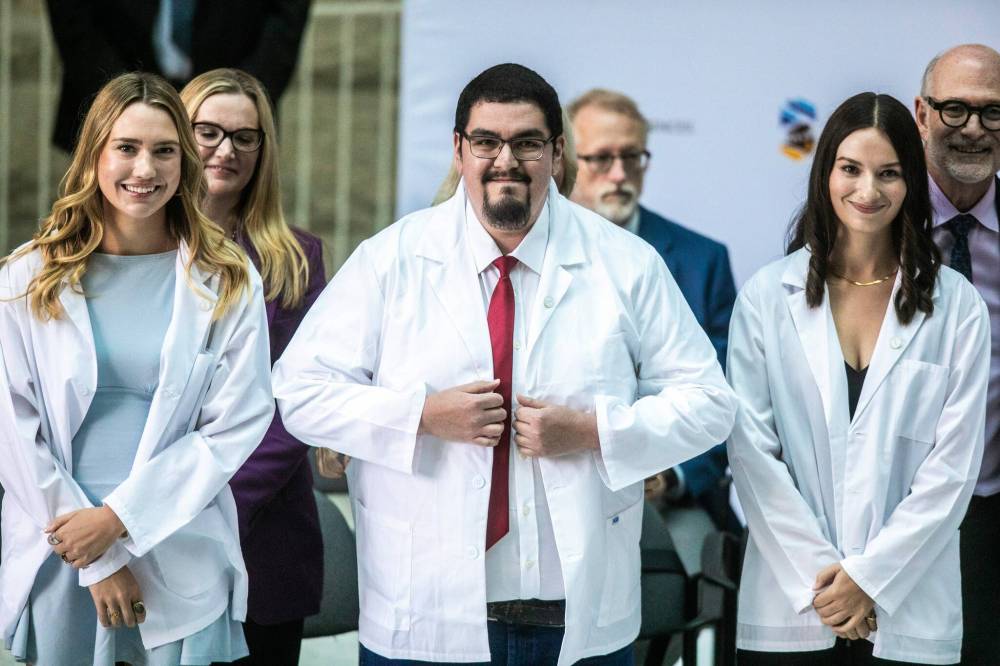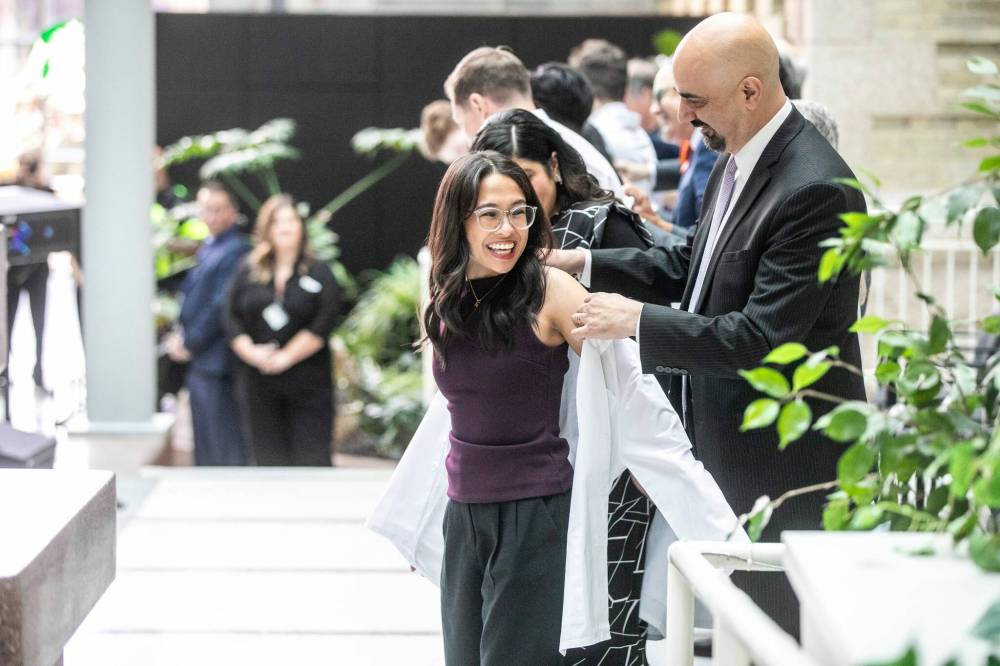U of M welcomes largest-ever incoming medical-school class
Indigenous medical students say they want to give back to their communities
Advertisement
Read this article for free:
or
Already have an account? Log in here »
To continue reading, please subscribe:
Monthly Digital Subscription
$0 for the first 4 weeks*
- Enjoy unlimited reading on winnipegfreepress.com
- Read the E-Edition, our digital replica newspaper
- Access News Break, our award-winning app
- Play interactive puzzles
*No charge for 4 weeks then price increases to the regular rate of $19.00 plus GST every four weeks. Offer available to new and qualified returning subscribers only. Cancel any time.
Monthly Digital Subscription
$4.75/week*
- Enjoy unlimited reading on winnipegfreepress.com
- Read the E-Edition, our digital replica newspaper
- Access News Break, our award-winning app
- Play interactive puzzles
*Billed as $19 plus GST every four weeks. Cancel any time.
To continue reading, please subscribe:
Add Free Press access to your Brandon Sun subscription for only an additional
$1 for the first 4 weeks*
*Your next subscription payment will increase by $1.00 and you will be charged $16.99 plus GST for four weeks. After four weeks, your payment will increase to $23.99 plus GST every four weeks.
Read unlimited articles for free today:
or
Already have an account? Log in here »
Hey there, time traveller!
This article was published 21/08/2024 (471 days ago), so information in it may no longer be current.
Antonina Kandiurin’s life has been impacted by the northern health-care system in a way that inspired her to make positive change.
Kandiurin, along with 139 other first-year medical students — the largest medical class in the University of Manitoba’s history — donned their white coats in a ceremony Wednesday morning at the Max Rady College of Medicine.
The 24-year-old lived in Churchill from the time she was six days old until she moved to Winnipeg to attend university after graduating high school. When her mom gave birth to Kandiurin and her siblings, she was forced to relocate to Winnipeg, with limited resources, because of the lack of services in the northern Manitoba community.

MIKAELA MACKENZIE / FREE PRESS
The newest University of Manitoba medical class recites the physicians’ pledge in a ceremony at the Max Rady College of Medicine on Wednesday.
She was diagnosed with Type 2 diabetes at the age of 16, and felt she had to advocate for herself. She knows vulnerable members of Indigenous communities — youths and elders, primarily — who may not be able to speak up for themselves.
She wants to be that voice for them.
“We’ve unfortunately experienced a lot of disparities, racism and unfortunate events in health care,” Kandiurin said after the ceremony.
“Seeing my family go through things and seeing things first-hand… really drove me to have a strong interest in medicine so that I can hopefully one day be a safe person, especially for Indigenous people in the North.”
Kandiurin, who is one of 13 other Indigenous students this year, said members of her community have been a huge support and she wants to make them proud, which is why she intends to stay in Manitoba.
“A lot of it just comes from my core values of family and community and knowing that they have always been the ones that have gotten me to this point,” she said. “It’s my turn to give back to them for all they have done for me.”
The U of M offers Manitoba’s only medical school, which is marking its 140th anniversary this year and, with provincial government support, has increased the class size for the first time in 15 years.
The goal is to train and retain new doctors and focus on rural and northern communities, Health Minister Uzoma Asagwara said, noting the province plans to hire 400 physicians over five years, including 100 by next spring.

MIKAELA MACKENZIE / FREE PRESS
Kelsey West dons his first white coat.
Asagwara said the province has “made progress,” but could not provide details on the number of doctors hired thus far.
The health minister encouraged the incoming students to stay in Manitoba.
“We have a very diverse group of learners, folks who are passionate about health care, passionate about people,” said Asagwara.
“It’s so important that we keep them in our province because Manitobans are going to benefit from their lens, from their lived experience, from their dedication to health care and their expertise.”
Kelsey West, an Indigenous student, plans to eventually practise medicine in his home community of Lake Manitoba First Nation.
West, 27, was inspired to go to medical school by a doctor who regularly visited his community and looked after three generations of his family.
“When I got my degree in Indigenous studies and I learned all the things that are affecting my people, that just gave me that extra push to say, ‘You know what? We need to address this,’ and I felt this was a way I could.”
West told a senior community member he was going to pursue medicine and she hugged him, saying she was looking forward to having an Indigenous doctor because she was scared to go to hospitals.

MIKAELA MACKENZIE / FREE PRESS
WRHA CEO Mike Nader cloaks Allison Afable during Wednesday’s white-coat ceremony for the newest University of Manitoba medical class.
“That broke my heart,” he said. “That’s not a sign of a health-care system that values all its members equally. I wanted to provide that care. I wanted to assist however I could.”
Adding more Indigenous physicians in Manitoba not only helps to address the overall shortage, but also increases culturally informed care that is lacking in some areas of the profession, he said.
Staying in Manitoba after graduation is a given, he said.
“It’s my home and I love it and I cherish it dearly,” he said. “It’s where I have my heart. It’s where I have my spirit.”
jura.mcilraith@freepress.mb.ca
History
Updated on Wednesday, August 21, 2024 5:12 PM CDT: Tweaks headline


